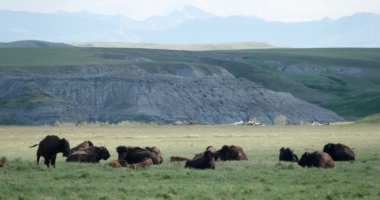Iinnii Days with the Conservation Ranching Team

We were incredibly grateful for the opportunity to attend Iinnii Days in Browning in June. The event is a celebration of Blackfeet ties to the Iinnii, which means buffalo in Blackfeet language. The three day gathering was full of stories, song, food, and community dialogue around the importance of Bison reintroduction to the culture, economy, and landscape of the Blackfeet Nation.
 The first day of the gathering began with a Bison harvest. After a blessing and acknowledgement of the bison’s relationship with the Blackfeet, community members and visitors participated in the harvest. People stepped up for their choice cut of meat and children picked out fat for their grandparents. Above the buzz of the harvest, a woman talked about the many use of Iinnii as the animal was processed, and highlighted the necessity of these events for teaching the next generation. We soon found ourselves helping the following day processing the hide!
The first day of the gathering began with a Bison harvest. After a blessing and acknowledgement of the bison’s relationship with the Blackfeet, community members and visitors participated in the harvest. People stepped up for their choice cut of meat and children picked out fat for their grandparents. Above the buzz of the harvest, a woman talked about the many use of Iinnii as the animal was processed, and highlighted the necessity of these events for teaching the next generation. We soon found ourselves helping the following day processing the hide!
From food, to clothing and lodging; the Iinnii have remained integral to Blackfeet society despite their near extinction in the late-19th century. On the second day, community members interfaced with a panel of bison conservationists, a representative from Glacier National Park, and Blackfeet food sovereignty advocates. The panel discussed the value of Indigenous led conservation, specifically work done through the Iinnii Initiative, which has repatriated bison back to Blackfeet Territory.
You may be wondering, what does a bird conservation organization like Montana Audubon have to do with bison conservation? Bison fill an important niche in our landscape as large grazers. While they have many functional similarities to cattle, bison love to roam! For the same reason that we work with rotational grazers through the Conservation Ranching Initiative, the roaming nature of bison drives biodiversity, heterogeneity of vegetation, and nutrient cycling on the plains. Many of our native songbirds rely on structural diversity throughout our native sagebrush and grasslands, while burrowing owls benefit from the prairie dog towns that follow heavily grazed areas. Generally speaking, what benefits the bison also benefits our native birds and we are happy to see their successful reintroduction in Northwestern Montana. Blackfeet Community College and Montana State University are now conducting an analysis of how bison impact soil health and vegetation in their pastures. It’s exciting to see new research projects emerge out of the Iinnii Initiative’s bison repatriation, and we are optimistic that bird conservation will be included in that programming soon.
You can learn more about the Iinnii Initiative on the Blackfeet Nation website and through this NPS webinar.
Written by Peter Dudley, Big Sky Conservation Corps (BSWC) Conservation Ranching Assistant